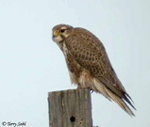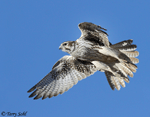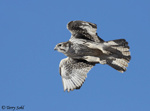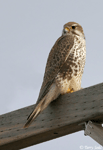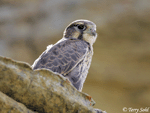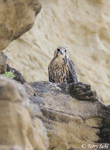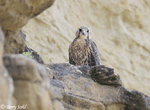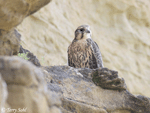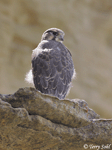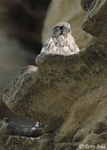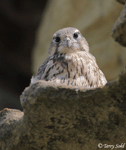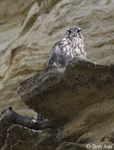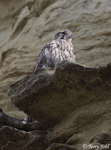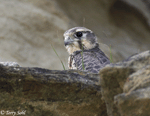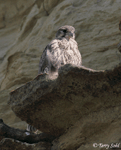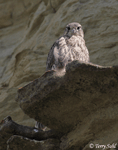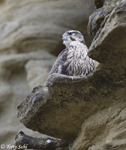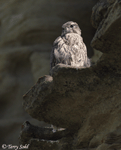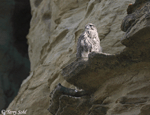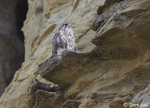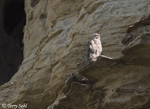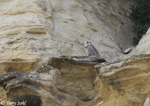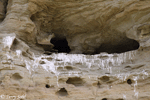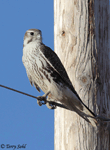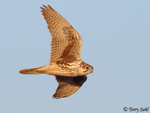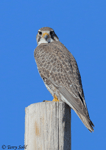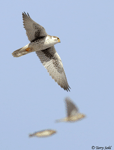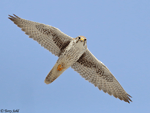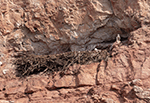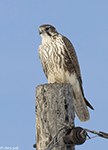| Length: 16 - 18 inches | Wingspan: 42 inches | Seasonality: All Seasons |
| ID Keys: Brown upperparts, pale underparts with brown spots, dark whiskers under eyes, dark mark at base of wing is evident in flight | ||
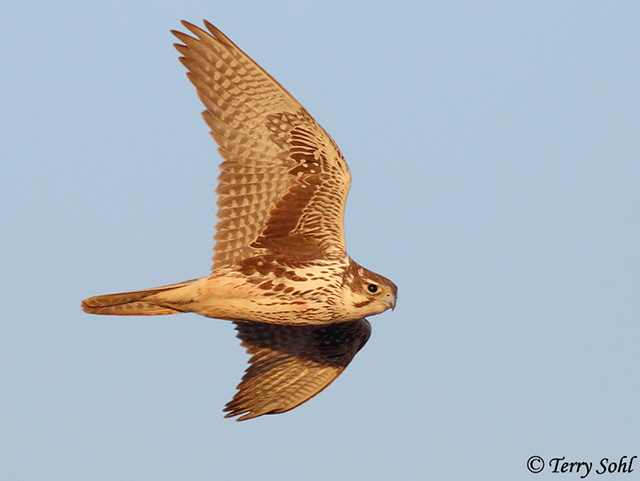 Similar in size to the
Peregrine Falcon, the Prairie Falcon is a fairly common resident of open spaces
in the Western U.S. While most commonly found in open grasslands of the
West, they have adapted to a human presence by sometimes frequenting urban areas
during the winter, taking advantage of the steady of supply of
"urbanized" birds. In South Dakota, they are found as nesting birds in
the far western edge of the state, but they disperse over most of the western
half of the state in the winter (with some sightings in eastern South Dakota as
well).
Similar in size to the
Peregrine Falcon, the Prairie Falcon is a fairly common resident of open spaces
in the Western U.S. While most commonly found in open grasslands of the
West, they have adapted to a human presence by sometimes frequenting urban areas
during the winter, taking advantage of the steady of supply of
"urbanized" birds. In South Dakota, they are found as nesting birds in
the far western edge of the state, but they disperse over most of the western
half of the state in the winter (with some sightings in eastern South Dakota as
well).
Habitat:
Primarily found in arid to semi-arid open areas such as grassland and rangeland, deserts, and above tree-line in mountainous parts of the west. Not commonly found near developed areas in the summer, some may winter near urban centers to take advantage of common residential birds.
Diet:
Primarily small mammals and small birds. Can feed on birds up to the size of prairie chickens, and on mammals as large as jackrabbits. They will also feed on large insects, lizards, and snakes. For many birds, the diet changes depending upon the season, with small mammals comprising the majority of the diet in summer, and birds such as Horned Larks, Lapland Longspurs, and Western Meadowlarks a heavy part of the winter diet.
Behavior:
Will hunt from a perch, swooping down for prey, or often by flying low over the ground, surprising prey. Males perform a wide variety of acrobatic flight displays during courtship.
Nesting:
April through July in South Dakota. The nest site is usually a protected crevice, cave, or ledge on a rocky cliff face, but they will also nest in trees or on man-made structures. Sometimes they will use a nest platform built by another species. They do little nest building of their own, as a normal site on a rocky cliff face is little more than a protected location with a bit of material to hold the eggs in place. The females lays 3 to 5 eggs, and she does most of the incubation. The young hatch after about 30 days, with young fledging from the nest after about 5-6 weeks.
Song:
Alarm call of a sharp ree-kree-kree-kree. They also make varied vocalizations during courtship.
- Click here to hear the alarm call of a Prairie Falcon1
- Click here to hear courtship screams of a courting pair2
Migration:
Primarily a permanent resident, but some move short distances to the south in the winter.
Interactive eBird Map:
Click here to access an interactive eBird map of Prairie Falcon sightings
Similar Species:
To differentiate from the several species of hawks that can be found in South Dakota, look for the characteristic upright and slim shape of a falcon at rest, and the long, slim wings of a bird in flight with rapid wingbeats compared to the broader wings and slower wingbeats of a hawk. Once identified as a falcon, the following falcon species may cause some identification challenges. The the dark "armpit" of a Prairie Falcon in flight is generally diagnostic compared to the other falcon species found in South Dakota.
- Gyrfalcon - Seasonality is one clue to differentiating a Gyrfalcon from a Prairie Falcon. Gyrfalcons are normally found in the far northern reaches of North America, and are only rare winter visitors in the lower 48 states. Prairie Falcons are more widely distributed in South Dakota in the winter, but they can be found in far western South Dakota at all seasons. In appearance, Gyrfalcons are the largest falcons in the world, and size differences are obvious...IF you happen to catch the two species together (not likely!). Size can be difficult to judge on a lone bird. There are some plumage differences between the two. Gyrfalcons have three color phases, a white, gray, and dark morph. White and dark morph birds are easily differentiated, but the gray-morph Gyrfalcon has the most similar plumage to a Prairie Falcon. Not the tone of the plumage, as gray-morph Gyrfalcons do have a cooler, more gray tone than the slightly warmer, browner tones of a Prairie Falcon. An obvious ID mark in flight is the dark "armpit" of the Prairie Falcon (not seen on a Gyrfalcon).
- Merlin - Merlins are also primarily winter visitors and migrants in South Dakota, although they are found as summer breeding birds in parts of the far western part of the state. Merlins are considerably smaller than a Prairie Falcon, a size difference large enough that even for a bird seen in isolation, size can often be used to differentiate them. Male Merlins have a two-toned look to them that differentiates them from Prairie Falcons, with different color tones on the upper mantle and their lower parts. Female Merlins are most likely to be confused with a Prairie Falcons, but are more heavily marked on their underparts than a Prairie Falcon. Prairie Falcons also have a more strongly marked face and obvious "mustache" than a Merlin.
- Peregrine Falcon - Peregrine Falcons aren't a common sight in South Dakota, but can be seen in almost any season. They're most common in migration, particularly during the spring, when they can be found following migrating waterfowl and shorebirds. Peregrine Falcons are similar in size to a Prairie Falcon, so plumage differences are the best way to differentiate them. Adult Peregrine Falcons have a dark hood and dark upper body, compared to the more brown upper body of a Prairie falcon with a face that has a clear, narrow mustache bordered by white on both sides. Adult Peregrine Falcons have barring on their flanks, compared to the lighter spotting of an adult Prairie Falcon. Juvenile Peregrine Falcons are most likely to be confused with a Prairie Falcon, but they are more heavily maked on their undersides, and lack the dark armpits of a Prairie Falcon (seen in flight).
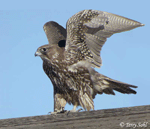 |
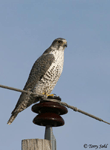 |
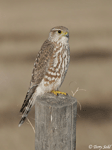 |
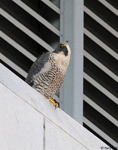 |
| Gyrfalcon (immature) | Gyrfalcon (Adult - gray-morph) | Merlin (female) | Peregrine Falcon (adult) |
South Dakota "Hotspot":
In summer, breeding is restricted to the far western edge of the state, where suitable nesting locations occur. The rocky cliffsides in North Cave Hills in Harding County are a good location to find nesting Prairie Falcons in the summer months (see photos below of young birds and a nesting site there). In the winter months, birds disperse and can be found much further east, where they feed on the large winter flocks of Horned Larks, Lapland Longspurs, and Snow Buntings that often form. The Fort Pierre National Grasslands and surround areas are usually great spots to find them in the winter months.
Conservation Status:
Some indications of sharp declines near developed areas, but otherwise stable. The IUCN currently considers the Prairie Falcon to be a species of "least concern".
Further Information:
Photo Information:
December 6th, 2014 - Near Presho, South Dakota -- Terry L. Sohl
Additional Photos:
Click on the image chips or text links below for additional, higher-resolution Prairie Falcon photos.
Audio File Credits:
- 1Bobby Wilcox, XC375912, Accessible at www.xeno-canto.org/375912.
- 2Nathan Pieplow, SC109296. Accessible at www.xeno-canto.org/109296
| Click on the map below for a higher-resolution view |
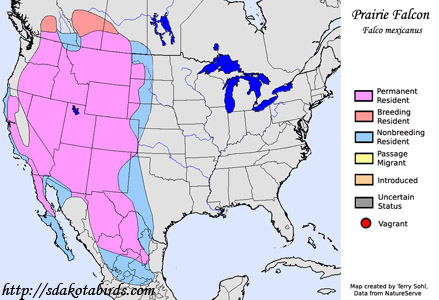 |
| South Dakota Status: Uncommon migrant and full-time resident in the western half of the state, rare migrant and winter visitor in the eastern half. |
Additional Prairie Falcon Photos
Click for a higher-resolution version of these photos
